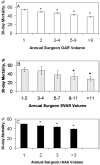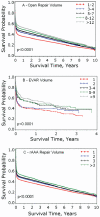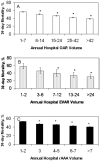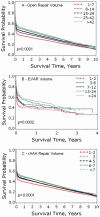National outcomes for the treatment of ruptured abdominal aortic aneurysm: comparison of open versus endovascular repairs
- PMID: 18971032
- PMCID: PMC2622721
- DOI: 10.1016/j.jvs.2008.06.036
National outcomes for the treatment of ruptured abdominal aortic aneurysm: comparison of open versus endovascular repairs
Abstract
Objectives: Endovascular repair (EVAR) of ruptured abdominal aortic aneurysms (rAAA) has been shown to acutely decrease procedural mortality compared to open aortic repair (OAR). However, little is known about the effect of choice of procedure; EVAR vs OAR, or the impact of physician and institution volume on long-term survival and outcome.
Methods: Patients hospitalized with rAAA who underwent either OAR or EVAR, were derived from the Medicare inpatient dataset (1995-2004) using ICD9 codes. We evaluated long-term survival after OAR and EVAR in the entire fee-for-service Medicare population, and then in patients matched by propensity score to create two similar cohorts for comparison with Kaplan-Meier analysis. Annual surgeon and hospital volumes of EVAR (elective and ruptured), OAR (elective and ruptured), and rAAA (EVAR and OAR) were divided into quintiles to determine if increasing volumes correlate with decreasing mortality. Predictors of survival were determined by Cox modeling.
Results: A total of 43,033 Medicare beneficiaries had rAAA repair: 41,969 had OAR and 1,064 had EVAR. The proportions of patients with diabetes, hypertension, cardiovascular, cerebrovascular, renal disease, hyperlipidemia, and cancer were statistically higher in the EVAR than in the OAR group, whereas lower extremity vascular disease was higher in the OAR group. The initial evaluation of EVAR vs OAR, prior to propensity matching, showed no statistical advantage in EVAR-survival after 90 days. The survival analysis of patients matched by propensity score showed a benefit of EVAR over OAR that persisted throughout the 4 years of follow-up (P = .0042). Perioperative and long-term survival after rAAA repair correlated with increasing annual surgeon and hospital volume in OAR and EVAR and also with rAAA experience. EVAR repair had a protective effect (HR = 0.857, P = .0061) on long-term survival controlling for comorbidities, demographics, and hospital and surgeon volume.
Conclusion: When EVAR and OAR patients are compared using a reliable statistical technique such as propensity analysis, the perioperative survival advantage of rAAA repaired endovascularly is maintained over the long term. Institutional experience with rAAA is critical for survival after either OAR or EVAR.
Figures






Comment in
-
Regarding "National outcomes for the treatment of ruptured abdominal aortic aneurysm: comparison of open versus endovascular repairs".J Vasc Surg. 2009 Jun;49(6):1634; author reply 1634-5. doi: 10.1016/j.jvs.2008.11.126. Epub 2009 Apr 26. J Vasc Surg. 2009. PMID: 19398184 No abstract available.
References
-
- Nicholls SC, Gardner JB, Meissner MH, Johansen HK. Rupture in small abdominal aortic aneurysms. J Vasc Surg. 1998;28:884–8. - PubMed
-
- Bown MJ, Sutton AJ, Bell PR, Sayers RD. A meta-analysis of 50 years of ruptured abdominal aortic aneurysm repair. Br J Surg. 2002;89:714–30. - PubMed
-
- Gerassimidis TS, Papazoglou KO, Kamparoudis AG, Konstantinidis K, Karkos CD, Karamanos D, Sfyroeras G. Endovascular management of ruptured abdominal aortic aneurysms: 6-year experience from a Greek center. J Vasc Surg. 2005;42:615–23. discussion 623. - PubMed
-
- Greco G, Egorova N, Anderson PL, Gelijns A, Moskowitz A, Nowygrod R, et al. Outcomes of endovascular treatment of ruptured abdominal aortic aneurysms. J Vasc Surg. 2006;43:453–9. - PubMed
-
- Resch T, Malina M, Lindblad B, Dias NV, Sonesson B, Ivancev K. Endovascular repair of ruptured abdominal aortic aneurysms: logistics and short-term results. J Endovasc Ther. 2003;10:440–6. - PubMed
Publication types
MeSH terms
Grants and funding
LinkOut - more resources
Full Text Sources

